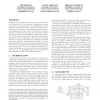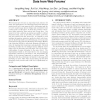613 search results - page 52 / 123 » Classification of Individuals with Complex Structure |
ECAL
2007
Springer
14 years 4 months ago
2007
Springer
It is well known that the evolution of cooperative behaviour is dependant upon certain environmental conditions. One such condition that has been extensively studied is the use of ...
WSC
2007
14 years 14 days ago
2007
Agent-based models (ABMs) are powerful in describing structured epidemiological processes involving human behavior and local interaction. The joint behavior of the agents can be v...
PVLDB
2010
13 years 8 months ago
2010
In XML search systems twig queries specify predicates on node values and on the structural relationships between nodes, and a key operation is to join individual query node matche...
WWW
2009
ACM
14 years 10 months ago
2009
ACM
Web forums have become an important data resource for many web applications, but extracting structured data from unstructured web forum pages is still a challenging task due to bo...
KI
2008
Springer
13 years 10 months ago
2008
Springer
The complexity of pedestrian spatio-temporal behaviour calls for the combination of several complementary empirical methods in order to comprehensively understand human motion beha...



